
Environment
Inside the fight to protect the Arctic’s “Water Heart”
How the Sahtuto’ine Dene of Déline created the Tsá Tué Biosphere Reserve, the world’s first such UNESCO site managed by an Indigenous community
- 1693 words
- 7 minutes
Environment
An agreement with the government says nations can move forward with feasibility study for new Indigenous Protected and Conserved Area in the Seal River watershed

The 50,000-square-kilometre Seal River watershed in northern Manitoba is one of the largest ecologically intact watersheds in the world. Teeming with biodiversity, its conservation value is almost without parallel. Located in the heart of the northern boreal forest, it is untouched by damming or industrial development. Beluga whales inhabit the mouth of the Seal River where it enters Hudson Bay; inland, the territory supports at least 25 known species at risk, such as barren-ground caribou, wolverines, and polar and grizzly bears. It’s also a critical breeding and migratory staging area for hundreds of species of birds. Roughly the size of Denmark or Costa Rica, permanently protecting it would add 0.4 per cent towards Canada’s goal of protecting 30 per cent of lands and waters by 2030.
Now four First Nations, under the umbrella of the Seal River Watershed Alliance, along with the governments of Canada and Manitoba, have taken the penultimate step towards that goal. In an emotional signing ceremony, held Jan. 18 during the Manitoba Keewatinowi Okimakanak Chiefs assembly in Winnipeg, leaders from those parties signed a memorandum of understanding to assess the feasibility of establishing an Indigenous Protected and Conserved Area (IPCA), and possible national park reserve, in the watershed.
The IPCA will be formally established if the committee leading the assessment recommends in favour of the plan and all parties approve.
“I can’t believe we’re here,” said Stephanie Thorassie, executive director of the Seal River Watershed Alliance and a member of the Sayisi Dene First Nation, opening her pre-signing remarks to the group. “We have worked hard to bring everyone to the table and find our shared aspirations for the watershed.”
Wab Kinew, the recently elected first Indigenous premier of Manitoba, and Stephen Guilbeault, federal minister of environment and climate change, both stressed their determination to see the Seal River Watershed IPCA realized. “We’re going to make sure this happens,” said Kinew. On the need for all parties to agree, Guilbeault said: “I believe we will.”
Crown support is critical, explains Ron Thiessen, executive director of CPAWS Manitoba. While the Nations in the Alliance can unilaterally declare an IPCA, the Manitoba and federal governments must agree to respect it to ensure its permanent protection.


Along with the conservation goals, there is a second thread woven into the IPCA process: reconciliation. IPCAs prioritize Indigenous rights and livelihoods, Indigenous leadership, Indigenous knowledge and Indigenous management. In this case, the watershed is the ancestral territory for the Sayisi Dene as well as the three other First Nations in the Seal River Watershed Alliance: Northlands Denesuline First Nation, Barren Lands First Nation and O-Pipon-Na-Piwin Cree Nation.
Despite their deep ties to these lands and waters, in 1956, the federal Department of Indian Affairs forcibly removed the Sayisi Dene from the land on baseless grounds that they were overharvesting caribou. Overnight, they went from a self-sustaining nomadic existence across northern Manitoba to being dumped on barren ground outside of Churchill with only tents, shacks and, later, substandard government housing to live in.
Two decades of disease, hunger, deaths, abuse and further displacement followed, before the first surviving Sayisi Dene nation members headed back out onto their land. As more joined them, they established a community on Tadoule Lake, on the south arm of the Seal River. That’s where many Sayisi Dene live today. In 2016, the federal government made a formal apology and paid the band more than $33 million in compensation.
“Despite all that trauma, our community is now leading the effort to protect the watershed. Not only for our nations, but for all people. I’m always proud to be Sayisi Dene, but today I’m extra proud,” Thorassie said at the announcement, followed by a joyous burst of applause.

The quest for an Indigenous-led solution to protect the watershed began as an ad hoc process soon after that federal apology. Spearheaded by Ernie Bussidor, a former Sayisi Dene chief, it also coincided with the national efforts of the Indigenous Circle of Experts whose 2018 report, We Rise Together, laid out a blueprint for the creation of IPCAs in Canada.
The four First Nations formalized their alliance in 2019 and held their first leaders meeting in early 2020 in Winnipeg. The following year, Thorassie succeeded Bussidor as executive director. Their work has blended outreach, dialogue, fact-finding, strategizing, forging alliances and lobbying. Much of the dialogue has been internal, with alliance and community representatives traveling the watershed to visit the four nations, interviewing Elders and land users, compiling stories, mapping traditional territories and building new ties between the groups.
In 2022, the alliance was one of 80 Indigenous communities to receive federal funding to launch a Land Guardians program. Community representatives who had already been on the ground building support for the IPCA were brought into that program, including a strong youth contingent. Along with taking up a core Guardians role as land stewards, they’ve done much of the legwork by gathering data to support the IPCA effort. This has drawn on traditional knowledge, as well as Western science for aspects such as GIS mapping and using autonomous recording devices (in partnership with the National Audubon Society) for bird monitoring.
The Guardians program has also given the youth first-time opportunities to experience the land and learn outdoor skills. As well as reconnecting with their traditional culture, this work will also help equip them to participate in the Indigenous eco-tourism economy the alliance hopes to develop once the IPCA is finalized.
On one trip out onto the land, said Chief Shirley Ducharme of O-Pipon-Na-Piwin Cree Nation, the youth experienced shooting the rapids, “which they hadn’t done in their lives,” and learned that it can take a week to travel a distance by water that only takes two hours by car. “[Previously], they couldn’t imagine how our [ancestors] relied on the waterways as transportation and to connect with other communities. So that was a great learning experience…and really touching and overwhelming for them,” she said.

Presently, only three Indigenous Protected Areas in Canada are formally recognized and listed in the Canadian Protected and Conserved Areas Database. How soon could the Seal River watershed IPCA join them?
The feasibility study has a two-year timeline, but Thorassie hopes to move faster given all the work the alliance has already completed. At one point, this step was expected sooner. Over a year ago, at COP15 in Montreal, the alliance, Minister Guilbeault and Manitoba’s former environment minister first announced plans for the feasibility study, pending some final details. But then things stalled. The reason, Guilbeault revealed at the signing, is that “the previous provincial government, after the announcement at COP15, seemed less interested in ensuring that the project could move forward swiftly.”
Things changed when Kinew’s government was elected in October. Soon after, the premier made a key decision — he exempted the watershed lands from mining claims. With that obstacle removed, the MOU could proceed.
Asked about that decision, Kinew quoted his government’s throne speech from November, which heralded a “new day” in Manitoba.
“There are some areas in northern Manitoba where we’re going to be looking at mining,” he explained. “But in this area, we’re going to be looking at the type of development that was spoken about today; development of a spiritual and cultural legacy for future generations, and development of eco-tourism and other economic opportunities.”
While Thorassie ended her formal remarks acknowledging that the work is not over, her words and expression before, during and after the signing were that of someone for whom the ultimate goal is finally in sight.
“For so long, outsiders dictated where we lived, where we went to school, how we wore our clothes, our hair, what language we spoke. Now our communities are standing up and defining how we want to care for these lands and waters,” she said. “We are holding the pen to this report, and this is what’s so powerful and so important about this moment.”
Are you passionate about Canadian geography?
You can support Canadian Geographic in 3 ways:

Environment
How the Sahtuto’ine Dene of Déline created the Tsá Tué Biosphere Reserve, the world’s first such UNESCO site managed by an Indigenous community

Places
In Banff National Park, Alberta, as in protected areas across the country, managers find it difficult to balance the desire of people to experience wilderness with an imperative to conserve it

Places
It’s an ambitious plan: take the traditional Parks Canada wilderness concept and plunk it in the country’s largest city. But can Toronto’s Rouge National Urban Park help balance city life with wildlife?

Environment
In February 2021, the world was introduced to Mutehekau Shipu — also known as the Magpie River — when the people of Ekuanitshit, Que. and the regional municipality made a joint declaration granting the river legal personhood and rights. The declaration carries broad implications for the fight to protect nature across Canada and around the world.